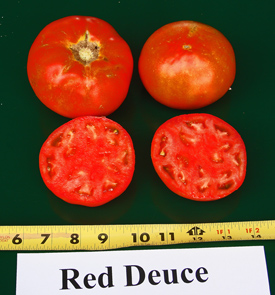|
What is the 2016 Rodeo Tomato?
 ‘Red Deuce’ tomato is a determinate plant which produces big yields of large to extra-large 10 oz. globe shaped fruit that have great eye-appeal and good eating quality. ‘Red Deuce’ has resistance to Verticillium Wilt, Fusarium Wilt (races 1, 2), Tobacco Mosaic Virus and Stemphylium.
‘Red Deuce’ tomato is a determinate plant which produces big yields of large to extra-large 10 oz. globe shaped fruit that have great eye-appeal and good eating quality. ‘Red Deuce’ has resistance to Verticillium Wilt, Fusarium Wilt (races 1, 2), Tobacco Mosaic Virus and Stemphylium.
Characteristics
- Fruit is globe-shaped, uniform ripening, and ripens to a deep red color
- Demonstrates fruit quality, uniformity has an exceptional firmness
- High yields of large to extra-large fruit that hold up well
- Performs well in early and mid-season plantings
- Plant habit provides excellent foliage protection to the crop
Disease Resistance Notations
- V - Verticillium wilt caused by the specified race of Verticillium albo-atrum, V. dahliae
- Fol - Fusarium wilt caused by the specified races of Fusarium oxysporum f. sp. Lycopersici
- TMV - Mosaic caused by tobacco mosaic virus
- S - Grey leaf spot caused by Stemphylium spp.
- Ss - Grey leaf spot caused by Stemphylium solani
Opinion about taste of tomatoes differs from person to person, so try several varieties to see which one tastes best to you when grown in your garden.
Have you ever wondered how some gardeners always harvest the first tomatoes of the season?
 In most cases these “early bird” winners are “potting-up” their plants in 1-gallon containers prior to setting them out in the garden for spring, when the soil and air temperatures have warmed up enough to support tomato plant growth and fruit setting (early March through the first week of April).
In most cases these “early bird” winners are “potting-up” their plants in 1-gallon containers prior to setting them out in the garden for spring, when the soil and air temperatures have warmed up enough to support tomato plant growth and fruit setting (early March through the first week of April).
To “pot up” your transplants, fill a one-to-three gallon black plastic nursery container with a pre-moistened premium potting mix. Enrich the potting mix with copious amounts of a slow release fertilizer made especially for containers, such as an 18-6-12 Osmocote analysis. If an organic fertilizer formulation is preferred, consider a 4-2-3 or similar analysis at twice the rate. If you want maximum fruit production, be generous with the fertilizer; as tomatoes are heavy feeders. Since these varieties are short statured in growth, good fertility will be required to produce optimum yields of 20 pounds plus per plant. The key plant nutrient will be nitrogen. If adequate plant fertility is not maintained, the tomato bush will be small, yellow in color and produce much less fruit. Place the transplants in the container. They can be planted deeply; tomatoes are one of the few plants that can tolerate deep planting. Adventitious roots will form along the whole stem. This is especially important if your transplants are leggy or top heavy. Start with healthy, dark green, well established transplants. They should acclimatize to the wind and sun.
The goal of the “potting up” activity is to maintain the fast growth rate established at the nursery. Place the potted up tomato in a full sun location out of the wind. The wind can injure foliage and reduce overall plant growth, so a small plant stake might be needed anchored to the main stem. A greenhouse is ideal, but many locations on the patio or the south side of the house also work well.
It is important to keep the tomatoes adequately watered BUT NOT OVER-WATERED. That is why; we start out with a Premium potting mix. Watering frequency will depend on the water-holding capacity of the potting mix used and the plant size. Check the mix moisture by digging around in the pot—if you feel moisture—DO NOT WATER. Too much watering of young plants can cause roots to rot and you will have to get replacement plants. Also, you should apply a dilute water soluble fertilizer, such as HastaGro, at least once a week when watering. The high quality potting mixes are very well drained so they usually will not become soggy. Reduce watering when the weather is overcast and/or cool. If the plant is subjected to more than a few hours of sub 40° F temperature it will stop growing. You will recognize this when the plant stops growing and you see purplish coloring on the leaves. This condition often happens if you plant the tomatoes directly into the garden before March 15th and are not covered with a plant cover like N-Sulate till about mid-April.
To maintain the tomato transplant in a growing state, move it to shelter when temperatures below 40° F are forecast. That may mean, moving the containers into the house on cold evenings.
If you do everything as described above, your “potted up" plants will become quite large, and may even begin blooming by late March or early April. The plants can then be transplanted to the vegetable garden or a much larger 20” diameter container. Do not let plants be transplanted with small fruit before moving to a permanent location. If fruit are allowed on transplants, the plants will be stunted when establishing them in the garden location. So, remove those fruits for ample plant establishment! Do not apply organic mulch around tomato plants until early May, when soil temperatures have warmed. Then mulch with an organic double shredded hardwood or native cedar type mulch. If the plant is grown in a container, be sure to water and continue feeding every week with a water soluble fertilizer as recommended on the label.
A tomato plant will produce a higher quality fruit if caged. Cages should be at least 4-5 feet tall with a 16-20 inch diameter. Anchoring the cages down will minimize the wind from turning over the cages. Drip irrigation is the best method to water. In six-to-eight weeks, you should be harvesting tomatoes and you’ll be the talk of your neighborhood.
Good Luck this spring with your new tomatoes. Remember, your fall tomato transplants go in as early as late June through the month of August. You don’t need to plant many, just do a good job in the few that you are growing.
Texas A&M AgriLife Extension Service
3355 Cherry Ridge, Suite 212
San Antonio, TX 78230-4818
210 631-0400
http://bexar-tx.tamu.edu
David Rodriguez is the Bexar County Extension Agent-Horticulture. For more information or questions call the Master Gardener 'Hotline' at (210) 631-0400 or email your questions to: info@bexarmg.org.
Educational programs of Texas A&M AgriLife Extension Service are open to all people without regard to race, color, sex, national origin, age, genetic information or veteran status. The Texas A&M University System, U.S. Department of Agriculture, and the County Commissioners Courts of Texas Cooperating
|



